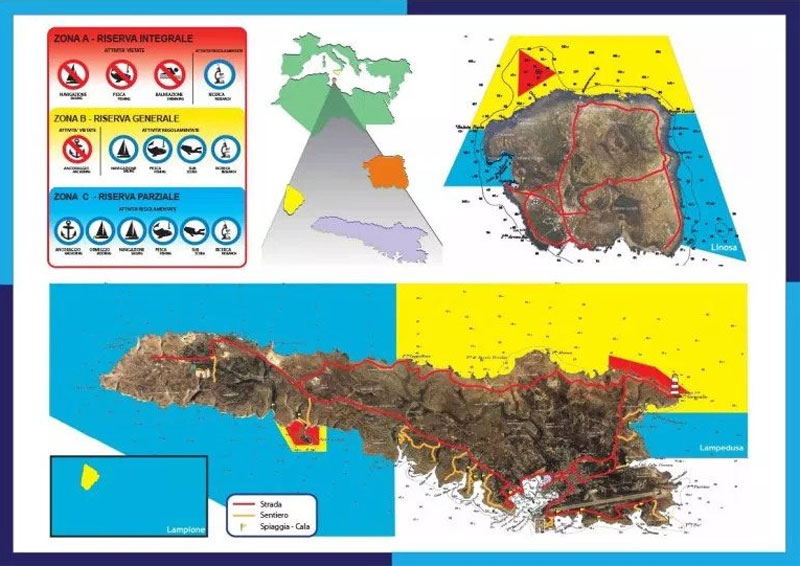
Lampedusa
Lampedusa resembles a raft in the middle of the sea, far from everything, except from the very different Linosa and the tiny Lampione.
In the inhabited center, the only one on the island, there is the airport: a long strip of concrete that connects the island to the continent, only through the flights of small planes, which however are numerous and connect it to the Italy, especially in Palermo.
LAMPEDUSA
Lampedusa is mostly desert. Only the caper plants and some endemic Maghrebi species live among its constantly windswept rocks.
In the past, however, Lampedusa was very green. In place of the current Mediterranean steppe there was a thick scrub, destroyed by forced deforestation and by the erosion of atmospheric agents. Portions of Mediterranean maquis still resist in the valleys and in the westernmost area of the island, where there is a forest of olive trees and the luxuriant past of an island plundered over the years is still alive.
In fact, towards the middle of the 19th century, about eighty settlers, mostly farmers, landed on the island and undertook a series of works to turn it into agricultural land. However, the results were not exciting and things got worse when the total deforestation was ordered to produce the coal necessary for a Sicily in full industrial revolution.
WHAT TO SEE IN LAMPEDUSA
Lampedusa is small and narrow. It extends over about 20 square km and the tour of the island can be done in a day by bicycle. Thanks to the shape of an inclined raft, it is surprising that, along the panoramic road that cuts the island from north to south, you can see the sea wherever you look.
Below we have selected 10 things to see absolutely in Lampedusa.
LIGHTHOUSE OF CAPO GRECALE
The Capo Grecale lighthouse is located in the eastern part of Lampedusa, in the Cala Creta area. The walk from the center of Lampedusa to the lighthouse along the main road is beautiful. The road curves and climbs along the barren land, with the sea on three sides. The lighthouse is under renovation, automatic and still functional.
GREEK CALA
Just before reaching the lighthouse, you come across Cala Greca: a small, uncrowded cove immersed in an area of Lampedusa where there are restaurants and bungalows in the shape of dammusi. A few meters further on is Mare Morto, a rocky cove where snorkelling is excellent. Cala Pisana (near the center and the airport) is also perfect for snorkelling. It can also be reached with a short trek, or by bicycle, from Cala Francese and along the cliff.
PANORAMIC STREET OF LAMPEDUSA
Continuing from via di Cala Creta and turning left before the lighthouse, you take the panoramic road. It´s impossible to go wrong because there are only two roads that cross Lampedusa. The overview runs close to the north coast, then becomes more central and in the points where it is slightly raised it offers a fantastic view with the sea from all sides: dark sea to the north and cliffs overlooking the blue on the opposite side.
CALA CHICK
In the westernmost area of Lampedusa there is one of the most beautiful coves on the island. Cala Pulcino has light blue water and large white stones. However, what you will like most about Cala Pulcino is not the sea (which is beautiful), but the path to reach it. The path starts from an area of olive trees near Casa Teresa and descends into a narrow completely green canyon. You walk on a carpet of fat leaves greeted by smells amplified by the wind blowing in the valley and by the sensation of seeing so much greenery all together, for the first time in Lampedusa. The trek lasts about forty minutes and is suitable for everyone.
DAMMUSO HOUSE TERESA
Casa Teresa is a sort of museum which, starting from the remains of a late 19th century dammuso, reconstructs its rooms and tells the story of agricultural life in the Lampedusa dammuso.
The dammuso was built with dry stone walls and a domed roof. The rooms were usually separate and accessible only from the outside. The thermal insulation system and the one for the rainwater supply make it a forerunner of the current sustainable architecture.
Casa Teresa is one of the largest dammusi and the oldest of those still intact. Take a walk in the garden with the circular orchard with dry stone walls around it to shelter it from strong winds.
ISLAND OF RABBITS
Considered by many to be one of the most beautiful beaches in the world, Rabbit Beach is truly wonderful. A long cobbled path leads down to the beach. From above, the view of the white beach and the blue sea includes the curious shape of the Isola dei Conigli (opposite the beach) and the barren hills that shelter the beach to the right.
Spiaggia dei Conigli is a breeding ground for the Caretta-Caretta turtle and is supervised in the summer by WWF volunteers who ensure that part of the beach is not occupied by bathers, as well as that it is completely closed at night.
TOBACCARA
Next to the Isola dei Conigli, continuing in the direction of the town of Lampedusa, there is one of the most spectacular valleys of the island: the Tabaccara. A path visible from the road crosses the valley. Once you reach the extreme point of the sea, the view of the Isola dei Conigli is magnificent. Those who reach the Tabaccara by boat dive into one of the bluest seas of Lampedusa, an ideal place for snorkelling and diving.
CALA MADONNA
On the coast of Lampedusa that goes from Tabaccara to the port there are some of the most beautiful coves. They are all signposted on the main road. Cala Madonna is a narrow and easily accessible cove. In the distant past it was a safe dock for the ships that stopped in Lampedusa and filled up with water from a nearby cistern.
SANCTUARY OF THE MADONNA OF PORTO SALVO
Above Cala Madonna there is a small sanctuary built where once there was a hermit´s cave. The hermit of Lampedusa has become famous for his alleged ability to welcome Christians and Muslims and venerate different sacred images depending on the guests on duty. The saying "do like the hermit of Lampedusa" is used a lot, especially in Sicily. The sanctuary is a small pastel-colored church that is definitely worth a visit.
GUITGIA
La Guitgia is the first large and white beach that you come across from the port going towards the island of Rabbits. It is still located in the inhabited center and a few meters from the port of Lampedusa. Despite this, it has a sea that is perhaps among the most beautiful on the island, particularly blue and clean. Obviously in the height of summer it is one of the busiest beaches on the island.
EXCURSION TO LINOSA
Every day from Lampedusa the ships stop in Linosa leave. The times allow for a day trip. Linosa is very different from Lampedusa: the beach and the rocks are dark, the sea is intense green and the island is very green and wooded. It is worth taking a trip to interrupt the desert view for a day and take a dip in a sea so close but so different. On the Liberty Lines website you will find the timetables and ferries available for the Lampedusa-Linosa route.
LAMPEDUSA CENTER
The town of Lampedusa is the only inhabited area on the whole island. Outside the village there are only a few dammusi scattered around and surrounded by bare nature. Lampedusa country develops around the port and via Roma, which is the street of shops and bars. At the port (both in the old port and in the new port) there are some fishmongers and fish restaurants. In via Roma stop for a drink at the Bar Royal, the historic bar of Lampedusa, while for desserts or pizza go to the nearby Bar dell´Amicizia.
BEACHES OF LAMPEDUSA
In summary, the beaches of Lampedusa are all located on the south side of the island, with a low and Caribbean coast, while the north side has a high and rocky cliff, which is impassable.




